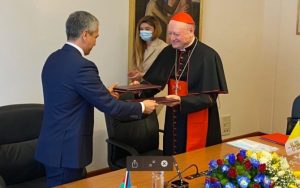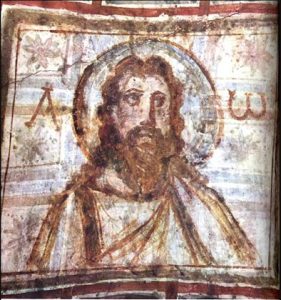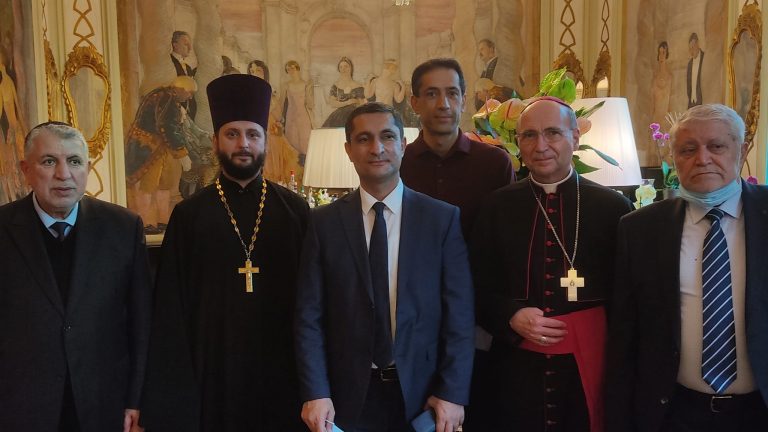More than an archeological work, the matter of the Commodilla Catacombs will be, in fact, a restoration under the sign of inter-religious dialogue.
“We are in the tenth year of cultural collaboration and next year we will celebrate 30 years of relations between the Holy See and Azerbaijan. Understood also from this is the importance of our Committee’s visit to the Vatican.” Rahman Mustafayev, the Azeri Ambassador to the Holy See, doesn’t hide his satisfaction over the renewal of the Agreement with the Vatican through the Heydar Aliyev Foundation.
An understanding that in the course of time has made possible restoration interventions of important monuments, such as those of the Marcellinus and Peter and Saint Sebastian Catacombs to the marble shovel of Saint Leo the Great’s altar in Saint Peter’s Basilica. The new project regards the Catacombs located in the Ostiense district, in via delle Sette Chiese.

The signing of the renewal of the Agreement took place in the Pontifical Council for Culture on March 4, 2021. The day before the Azeri delegation — led by Anar Alakbarov, Director of the Heydar Aliyev Foundation (presided by Mehriban Aliyeva, wife of the Azeri President), and by Soltan Mammadov, Head of the Foundation’s International Relations Department –, visited the Catacombs together with Cardinal Gianfranco Ravasi, President of the Pontifical Commission for Sacred Archaeology, and with the President of the Rome VIII Municipality, Amedeo Ciaccheri.
The objective of the conservation project is the enhancement of the Commodilla Catacombs in view of their opening to the public, with particular attention to two poles: “Leo’s Region” and the so-called “Basilichetta,” dedicated to the martyrs Felice and Adautto.

One of the most important aspects is that of the inter-religious dialogue. The Ambassador believes in particular that if a “Muslim country carries out works in a Christian country, such projects promote Christianity in the whole world.” To stress this, the composition of the delegation that came from Azerbaijan was emblematic. Taking part in fact were Haji Sabir Hasanli, Muslims’ Deputy of the Caucasus, Rector of the Islamic University of Baku and President of the Heydar Mosque; Milikh Yevdayev, Head of the Jewish Community of the mountains; the Archpriest Mefodij Afandieyev, Rector of the Orthodox Church of Saint Michael of Baku; and Catholic Bishop Vladimir Fekete, a Salesian. The objective was also to have exponents of other religions know the importance and beauty of Rome’s religious patrimony.
During the meeting, following the signing of the Agreement, all stressed the atmosphere of tolerance and peaceful coexistence existing in Azerbaijan, which fosters collaboration and inter-religious dialogue. During the Soviet regime all religions suffered intense persecution. In fact, the Catholic Church disappeared; there has been a stable presence only since 2000. Then there were the trips of Saint John Paul II in 2002 and of Francis in 2016. Both were witnesses of this atmosphere between the different religions,” recalled Hasanli.
During the Communist domination, there were 17 Mosques in a country that is 96% Muslim. Now there are close to 2,400. And the government’s role is determinant. According to Hasanli, the intention is to reconstruct them also in Nagorno Karabakh, together with the churches destroyed during the war.
The aspect of contribution, also financial, to religious communities is one of the most interesting of this Caucasian country. As Yevdayev recalled, two synagogues were built with State funds. The same happened for centers of Orthodox and Catholic worship. Moreover, all religions receive an annual budget directly from presidential funds.
“I heard from the President the reasons for this attitude,” explained Monsignor Fekete. “The State is secular,” he said to me, “but I understand very well the importance of religious values and I want to support them because it’s necessary to maintain the traditional and religious values for the future of my country,” — a decidedly more modern and farsighted vision of secularism than that present in so many Western States. “I can confirm the testimony of my brothers,” added the Bishop. “There is the capacity to have different nationalities and religions live together in harmony with the sentiments of the people.”
The Salesian Bishop is of Slovak origin but he has lived in Azerbaijan for 12 years. And he is keen to remember the country’s Christian roots from apostolic times. “Returning to India, Bartholomew was martyred in the locality that is identified with Baku, in the place where an Orthodox Church rises. Although we Catholics are few, especially small communities of foreign workers, we aren’t treated as a sect but as a Church, which can carry out its service for the good of the Azeri people. Then, as Salesians, we carry forward many educational and social projects.” Cardinal Bertone, then Vatican Secretary of State, consecrated the present Cathedral in 2007.
“This atmosphere of multi-confessionality and friendship comes from afar, concludes Afandieyev, from the fact of having lived beautiful and awful moments side by side. Azerbaijan’s cultural model is its logical continuation. The relationship that exists among us demonstrates that religion doesn’t divide but unites people. And it has two advantages. The first is that, in the Constitution, there is freedom of worship and we use it. The second important aspect is that the intention to live in peace and prosperity did not descend from on high but came from the people.”
It is an objective testimony of friendship and mutual trust that bodes well for the future. It’s no accident that the Ambassador suggested to the Holy See that, under the sign of inter-religious dialogue, it begin further initiatives of a cultural and social character, also in Azerbaijan.










